Optimization of Microstructure and Strength–Ductility Synergy in Selective Laser-Melted Ti6Al4V Alloy via Chessboard Scanning Strategy
Abstract
1. Introduction
2. Materials and Methods
2.1. Material
2.2. Process Parameters
2.3. Characterization
3. Results and Discussion
3.1. Microstructure Characteristics
3.2. Grain Orientation
3.3. Mechanical Properties
4. Conclusions
- (1)
- All samples predominantly exhibit an interlaced distribution of needle-like α′ martensitic structures. Compared to alternating and stripe scanning strategies, the chessboard scanning strategy segments the scanning area and frequently changes the scanning path. This approach suppresses directional solidification and promotes an isotropic microstructure. Pole figures and inverse pole figures further confirm that the grain orientation in the chessboard-scanned samples is randomly distributed. These samples show the lowest random distribution density (6.605 mrd) and the weakest texture strength, significantly reducing anisotropy.
- (2)
- The tensile fracture surface of the chessboard-scanned samples exhibits uniformly distributed ductile dimples, primarily governed by ductile fracture. In contrast, the fracture surface of the alternating and stripe scanning samples shows a mixed feature of dimples and cleavage, leading to reduced elongation. TEM combined with KAM mapping analysis reveals a higher dislocation density in the chessboard-scanned samples, with a complex network of cross-slip and dislocation entanglements.
- (3)
- The chessboard scanning strategy increased the α′ martensitic phase content to 53.3% and refined the grain size to 88.64 ± 10.79 μm, significantly enhancing the grain refinement strengthening effect. Combined with the synergistic effects of high strengthened phase content and dislocation strengthening, both strength and ductility were optimized. This strategy offers a new approach for improving the mechanical properties of Ti6Al4V alloy in additive manufacturing. In the future, it could be extended to optimize other high-performance alloys and multi-material systems, advancing the practical application of high-strength, high-ductility materials.
Author Contributions
Funding
Data Availability Statement
Conflicts of Interest
References
- Tang, M.K.; Zhang, L.C.; Zhang, N. Microstructural evolution, mechanical and tribological properties of TiC/Ti6Al4V composites with unique microstructure prepared by SLM. Mater. Sci. Eng. A 2021, 814, 141187. [Google Scholar] [CrossRef]
- Luo, Y.W.; Wang, M.Y.; Zhu, J.; Tu, J.G.; Jiao, S.Q. Microstructure and Corrosion Resistance of Ti6Al4V Manufactured by Laser Powder Bed Fusion. Metals 2023, 13, 496. [Google Scholar] [CrossRef]
- Islam, S.A.; Hao, L.; Javaid, Z.; Xiong, W.; Li, Y.; Jamil, Y.; Chen, Q.Y.; Han, G.C. Surface Roughness of Interior Fine Flow Channels in Selective Laser Melted Ti-6Al-4V Alloy Components. Micromachines 2024, 15, 348. [Google Scholar] [CrossRef]
- Zhao, B.J.; Wang, H.; Qiao, N.; Wang, C.; Hu, M. Corrosion resistance characteristics of a Ti-6Al-4V alloy scaffold that is fabricated via electron beam melting and selective laser melting for implantation in vivo. Mater. Sci. Eng. C 2017, 70, 832–841. [Google Scholar] [CrossRef]
- Gisario, A.; Kazarian, M.; Martina, F.; Mehrpouya, M. Metal additive manufacturing in the commercial aviation industry: A review. J. Manuf. Syst. 2019, 53, 124–149. [Google Scholar] [CrossRef]
- Zhang, D.Y.; Feng, Z.; Wang, C.J.; Wang, W.D.; Liu, Z.; Niu, W. Comparison of microstructures and mechanical properties of Inconel 718 alloy processed by selective laser melting and casting. Mater. Sci. Eng. A 2018, 724, 357–367. [Google Scholar] [CrossRef]
- Shin, W.S.; Son, B.; Song, W.S.; Sohn, H.; Jang, H.; Kim, Y.J.; Park, C. Heat treatment effect on the microstructure, mechanical properties, and wear behaviors of stainless steel 316L prepared via selective laser melting. Mater. Sci. Eng. A 2021, 806, 140805. [Google Scholar] [CrossRef]
- Liu, Y.Q.; Shan, Z.D.; Yang, X.J.; Jiao, H.W.; Huang, W.Y. Effect of Scanning Strategies on the Microstructure and Mechanical Properties of Ti-22Al-25Nb Alloy Fabricated through Selective Laser Melting. Metals 2023, 13, 634. [Google Scholar] [CrossRef]
- Pal, S.; Finšgar, M.; Hudák, R.; Rajťúková, V.; Brajlih, T.; Gubeljak, N.; Drstvenšek, I. Mechanisms of defect formation in Ti-6Al-4V product during re-melting of layers in selective laser melting. J. Manuf. Process. 2023, 105, 260–275. [Google Scholar] [CrossRef]
- Eshawish, N.; Malinov, S.; Sha, W. Effect of Solution Treatment and Cooling Rate on the Microstructure and Hardness of Ti-6Al-4V Alloy Manufactured by Selective Laser Melting Before and After Hot Isostatic Pressing Treatment. J. Mater. Eng. Perform. 2022, 31, 3550–3558. [Google Scholar] [CrossRef]
- Xiong, Z.H.; Liu, S.L.; Li, S.F.; Shi, Y.; Yang, Y.F.; Misra, R.D.K. Role of melt pool boundary condition in determining the mechanical properties of selective laser melting AlSi10Mg alloy. Mater. Sci. Eng. A 2019, 740–741, 148–156. [Google Scholar] [CrossRef]
- Khorasani, A.M.; Gibson, I.; Goldberg, M.; Littlefair, G. A survey on mechanisms and critical parameters on solidification of selective laser melting during fabrication of Ti-6Al-4V prosthetic acetabular cup. Mater. Des. 2016, 103, 348–355. [Google Scholar] [CrossRef]
- Ye, D.S.; Zhu, K.P.; Fuh, J.Y.H.; Zhang, Y.J.; Soon, H.G. The investigation of plume and spatter signatures on melted states in selective laser melting. Opt. Laser Technol. 2018, 111, 395–406. [Google Scholar] [CrossRef]
- Le, K.Q.; Tang, C.; Wong, C.H. On the study of keyhole-mode melting in selective laser melting process. Int. J. Therm. Sci. 2019, 145, 105992. [Google Scholar] [CrossRef]
- Yu, G.Q.; Gu, D.D.; Dai, D.H.; Xia, M.J.; Ma, C.L.; Chang, K. Influence of processing parameters on laser penetration depth and melting/re-melting densification during selective laser melting of aluminum alloy. Appl. Phys. A 2016, 122, 891. [Google Scholar] [CrossRef]
- Thijs, L.; Verhaeghe, F.; Craeghs, T.; Humbeeck, J.V.; Kruth, J.P. A study of the microstructural evolution during selective laser melting of Ti–6Al–4V. Acta Mater. 2010, 58, 3303–3312. [Google Scholar] [CrossRef]
- Khorasani, A.M.; Gibson, I.; Awan, U.S.; Ghaderi, A. The effect of SLM process parameters on density, hardness, tensile strength and surface quality of Ti-6Al-4V. Addit. Manuf. 2019, 25, 176–186. [Google Scholar] [CrossRef]
- Larimian, T.; Kannan, M.; Grzesiak, D.; AlMangour, B.; Borkar, T. Effect of energy density and scanning strategy on densification, microstructure and mechanical properties of 316L stainless steel processed via selective laser melting. Mater. Sci. Eng. A 2020, 770, 138455. [Google Scholar] [CrossRef]
- McLouth, T.D.; Witkin, D.B.; Bean, G.E.; Sitzman, S.D.; Adams, P.M.; Lohser, J.M.; Yang, J.M.; Zaldivar, R.J. Variations in ambient and elevated temperature mechanical behavior of IN718 manufactured by selective laser melting via process parameter control. Mater. Sci. Eng. A 2020, 780, 139184. [Google Scholar] [CrossRef]
- Javidrad, H.R.; Ghanbari, M.; Javidrad, F. Effect of scanning pattern and volumetric energy density on the properties of selective laser melting Ti-6Al-4V specimens. J. Mater. Res. Technol. 2021, 12, 989–998. [Google Scholar] [CrossRef]
- Jing, Y.L.; Wang, P.; Yan, X.L. Effect of Process Parameters and Layer Thickness on the Quality and Performance of Ti-6Al-4V Fabricated via Selective Laser Melting. Coatings 2021, 11, 1323. [Google Scholar] [CrossRef]
- Strantza, M.; Ganeriwala, R.K.; Clausen, B.; Phan, T.Q.; Levine, L.E.; Pagan, D.C.; Ruff, J.P.C.; King, W.E.; Johnson, N.S.; Martinez, R.M.; et al. Effect of the scanning strategy on the formation of residual stresses in additively manufactured Ti-6Al-4V. Addit. Manuf. 2021, 45, 102003. [Google Scholar] [CrossRef]
- Chang, S.J.; Wei, Z.X. Influences of the scanning strategy on surface roughness in selective laser melting. Proc. Inst. Mech. Eng. Part B J. Eng. Manuf. 2020, 236, 14. [Google Scholar] [CrossRef]
- Wan, H.Y.; Zhou, Z.J.; Li, C.P.; Chen, G.F.; Zhang, G.P. Effect of scanning strategy on mechanical properties of selective laser melted Inconel 718. Mater. Sci. Eng. A 2019, 753, 42–48. [Google Scholar] [CrossRef]
- Zhang, H.M.; Gu, D.D.; Ma, C.L.; Guo, M.; Wang, R.; Yang, J.K.; Ge, Q. Microstructure and tribological property of selective laser melted Ni-based composites using different scanning strategies. Vacuum 2020, 177, 109439. [Google Scholar] [CrossRef]
- Giganto, S.; Martínez-Pellitero, S.; Barreiro, J.; Leo, P.; Castro-Sastre, M.Á. Impact of the laser scanning strategy on the quality of 17-4PH stainless steel parts manufactured by selective laser melting. J. Mater. Res. Technol. 2022, 20, 2734–2747. [Google Scholar] [CrossRef]
- Shi, W.T.; Han, Y.F.; Li, J.H.; Liu, Y.D.; Zhou, Y.S.; Lin, Y.X. Investigation of the scanning strategy on the microstructure and tensile property of Ti6Al4V alloy fabricated by selective laser melting. Proc. Inst. Mech. Eng. Part C J. Mech. Eng. Sci. 2022, 237, 1. [Google Scholar] [CrossRef]
- Song, Y.N.; Sun, Q.D.; Guo, K.; Wang, X.B.; Liu, J.W.; Sun, J. Effect of scanning strategies on the microstructure and mechanical behavior of 316L stainless steel fabricated by selective laser melting. Mater. Sci. Eng. A 2020, 793, 139879. [Google Scholar] [CrossRef]
- Liu, J.W.; Sun, Q.D.; Zhou, C.A.; Wang, X.B.; Li, H.; Guo, K.; Sun, J. Achieving Ti6Al4V alloys with both high strength and ductility via selective laser melting. Mater. Sci. Eng. A 2019, 766, 138319. [Google Scholar] [CrossRef]
- ASTM E8/E8M-22; Standard Test Methods for Tension Testing of Metallic Materials. ASTM International: West Conshohocken, PA, USA, 2022. [CrossRef]
- Bartlett, J.L.; Li, X.D. An overview of residual stresses in metal powder bed fusion. Addit. Manuf. 2019, 27, 131–149. [Google Scholar] [CrossRef]
- Xu, W.; Brandt, M.; Sun, S.; Elambasseril, J.; Liu, Q.; Latham, K.; Xia, K.; Qian, M. Additive manufacturing of strong and ductile Ti–6Al–4V by selective laser melting via in situ martensite decomposition. Acta Mater. 2015, 85, 74–84. [Google Scholar] [CrossRef]
- Nong, X.D.; Zhou, X.L. Effect of scanning strategy on the microstructure, texture, and mechanical properties of 15-5PH stainless steel processed by selective laser melting. Mater. Charact. 2021, 174, 111012. [Google Scholar] [CrossRef]
- Ali, H.; Ghadbeigi, H.; Mumtaz, K. Effect of scanning strategies on residual stress and mechanical properties of Selective Laser Melted Ti6Al4V. Mater. Sci. Eng. A 2018, 712, 175–187. [Google Scholar] [CrossRef]
- Lewandowski, J.J.; Seifi, M. Metal Additive Manufacturing: A Review of Mechanical Properties. Annu. Rev. Mater. Res. 2016, 46, 151–186. [Google Scholar] [CrossRef]
- Parry, L.; Ashcroft, I.A.; Wildman, R.D. Understanding the effect of laser scan strategy on residual stress in selective laser melting through thermo-mechanical simulation. Addit. Manuf. 2016, 12, 1–15. [Google Scholar] [CrossRef]
- Liu, S.Y.; Shin, Y.C. Additive manufacturing of Ti6Al4V alloy: A review. Mater. Des. 2019, 164, 107552. [Google Scholar] [CrossRef]
- Galarraga, H.; Warren, R.J.; Lados, D.A.; Dehoff, R.R.; Kirka, M.M.; Nandwana, P. Effects of heat treatments on microstructure and properties of Ti-6Al-4V ELI alloy fabricated via electron beam melting (EBM). Mater. Sci. Eng. A 2017, 685, 417–428. [Google Scholar] [CrossRef]
- Hahn, J.D.; Shin, Y.C.; Krane, M.J.M. Laser transformation hardening of Ti-6Al-4V in solid state with accompanying kinetic model. Surf. Eng. 2007, 23, 78–82. [Google Scholar] [CrossRef]
- Ahmed, T.; Rack, H.J. Phase transformations during cooling in α+β titanium alloys. Mater. Sci. Eng. A 1998, 243, 206–211. [Google Scholar] [CrossRef]
- Wei, F.X.; Cheng, B.S.; Chew, L.T.; Lee, J.J.; Cheong, K.H.; Wu, J.; Zhu, Q.; Tan, C.C. Grain distribution characteristics and effect of diverse size distribution on the Hall-Petch relationship for additively manufactured metal alloys. J. Mater. Res. Technol. 2022, 20, 4130–4136. [Google Scholar] [CrossRef]
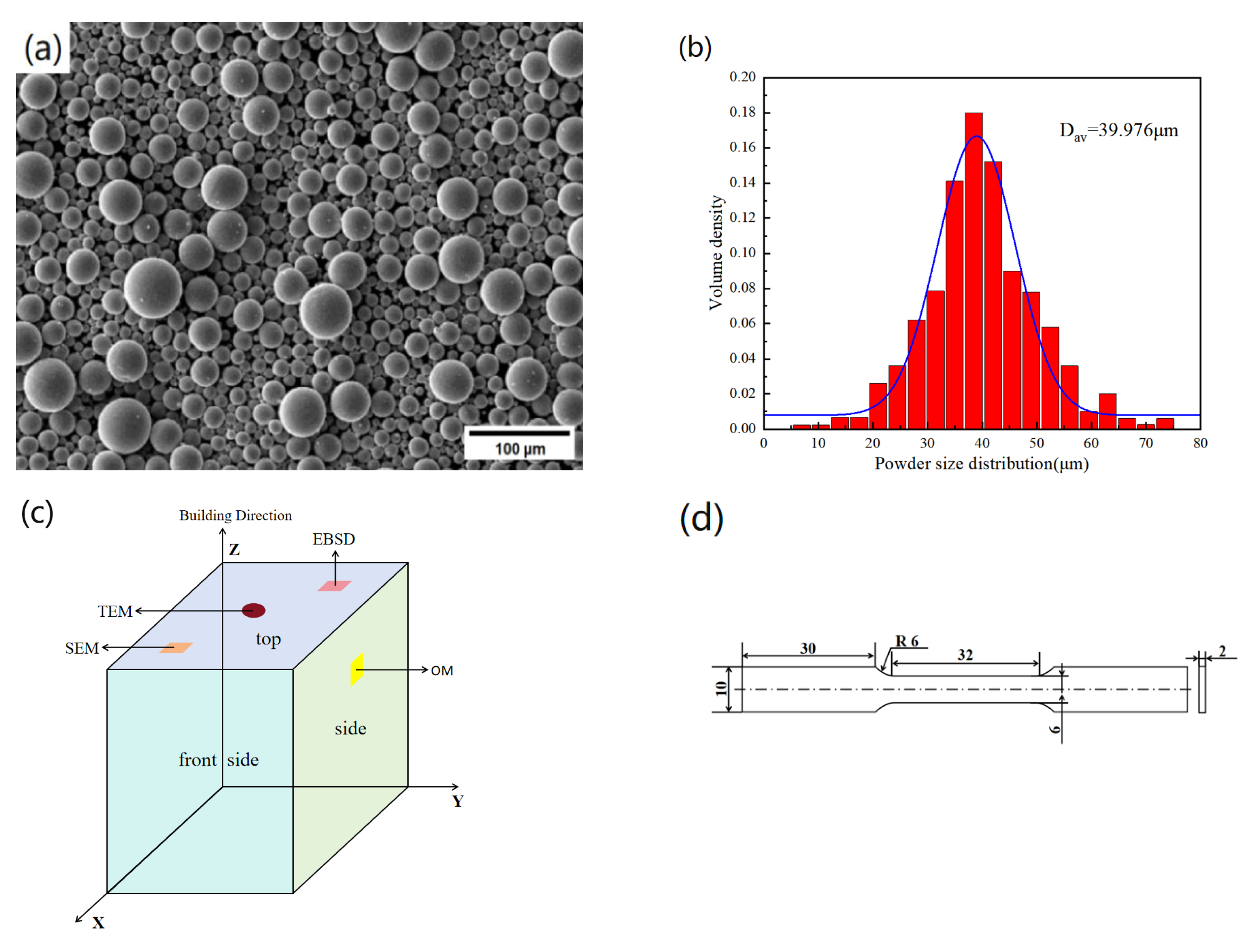








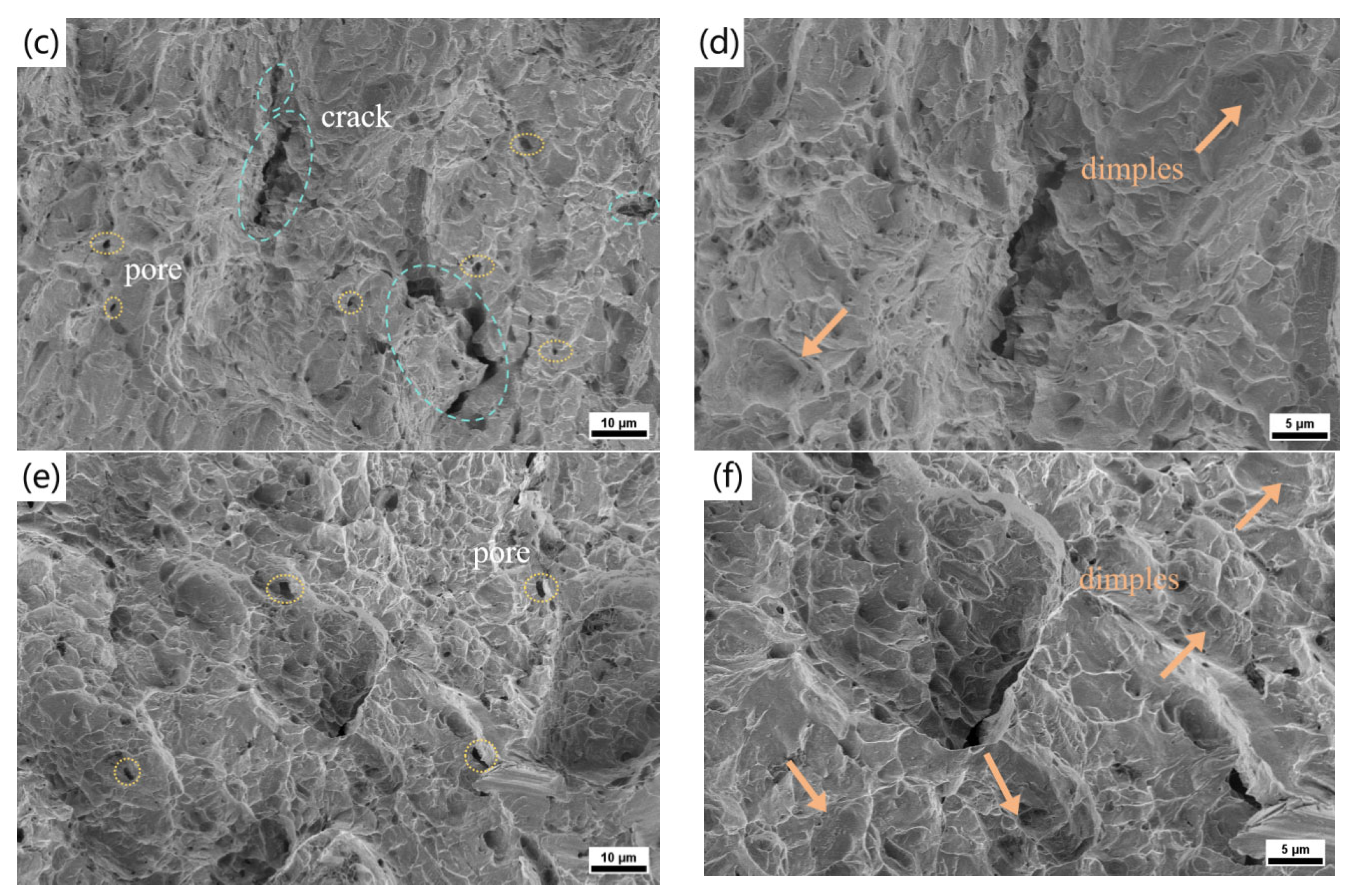
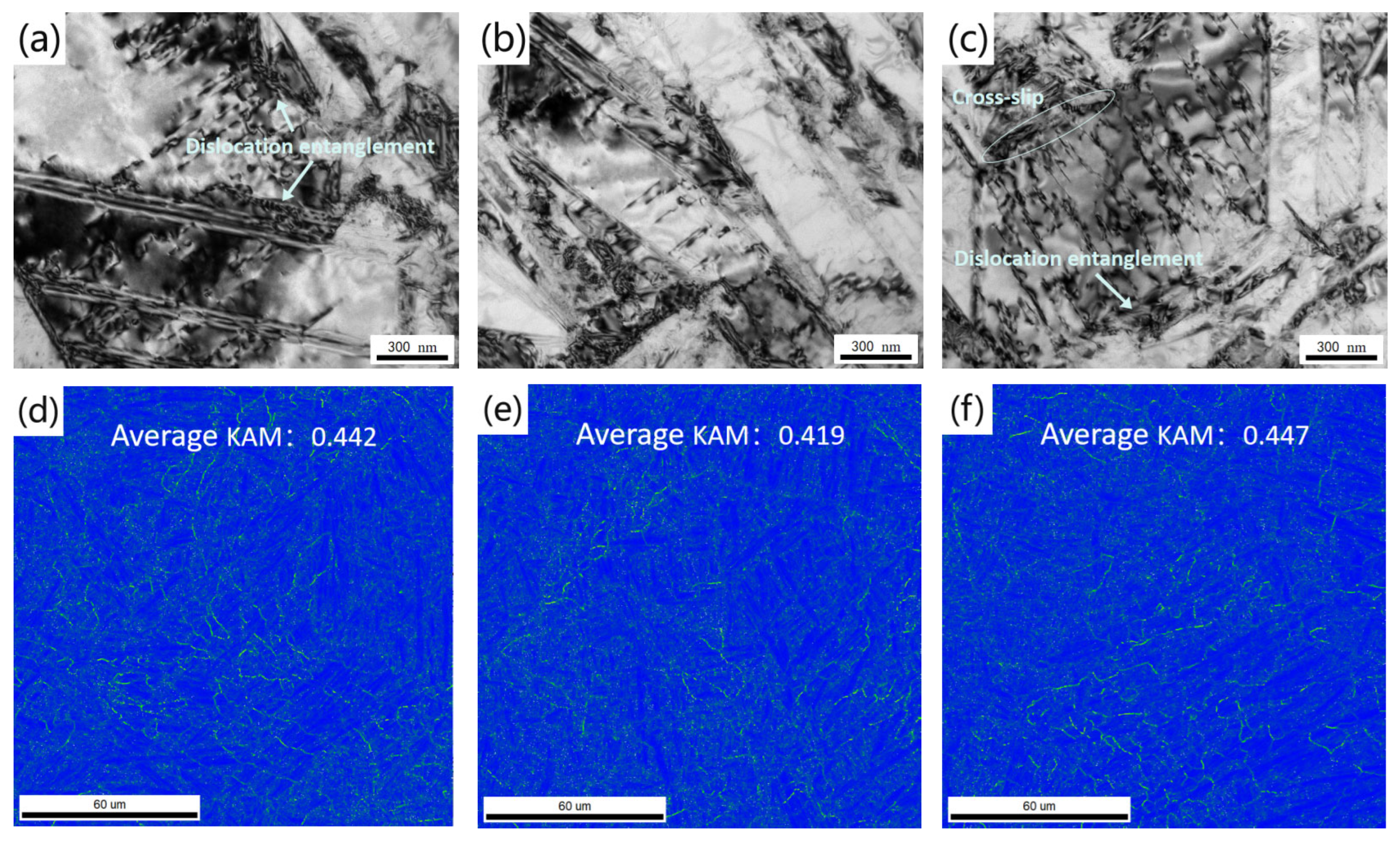
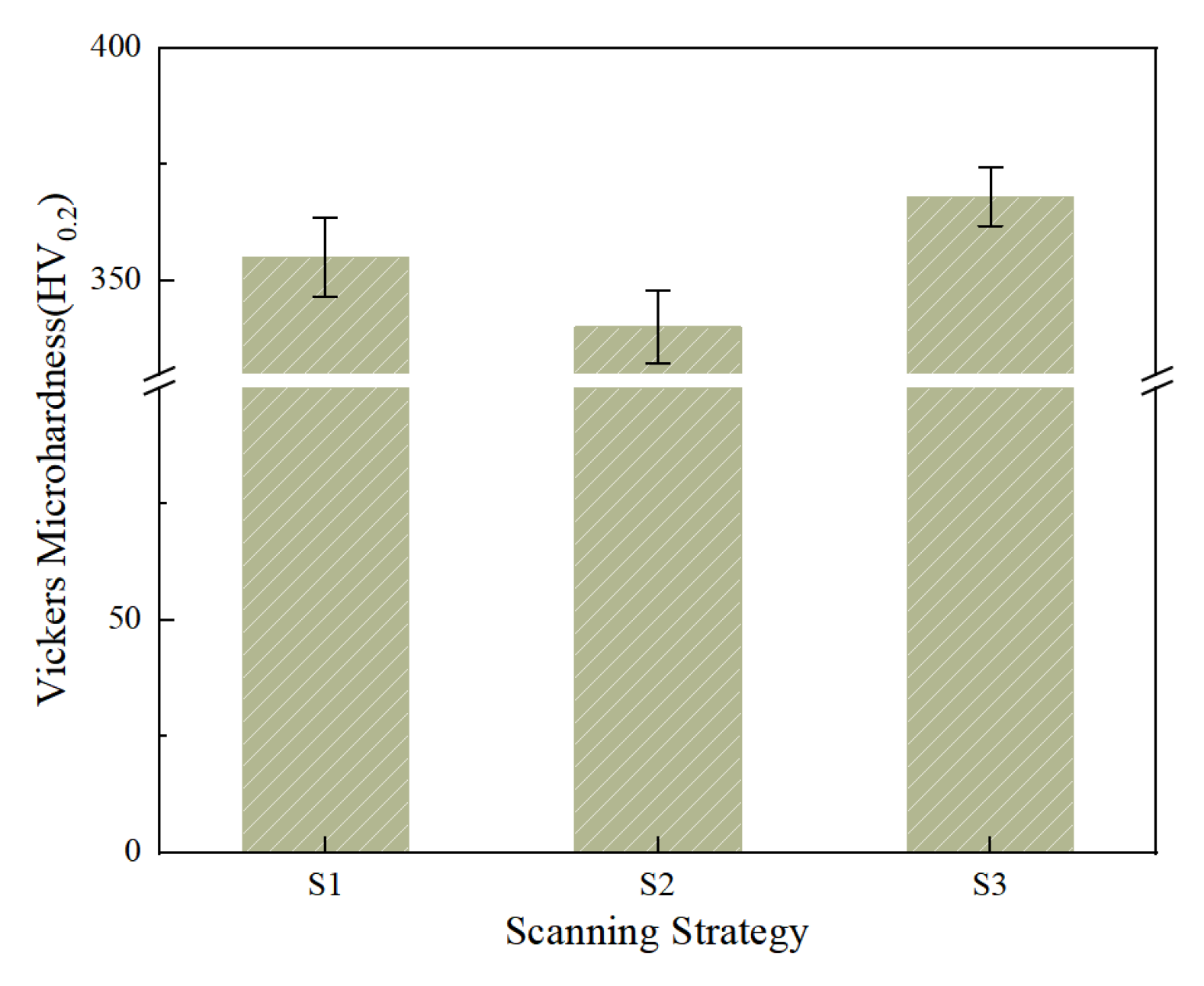
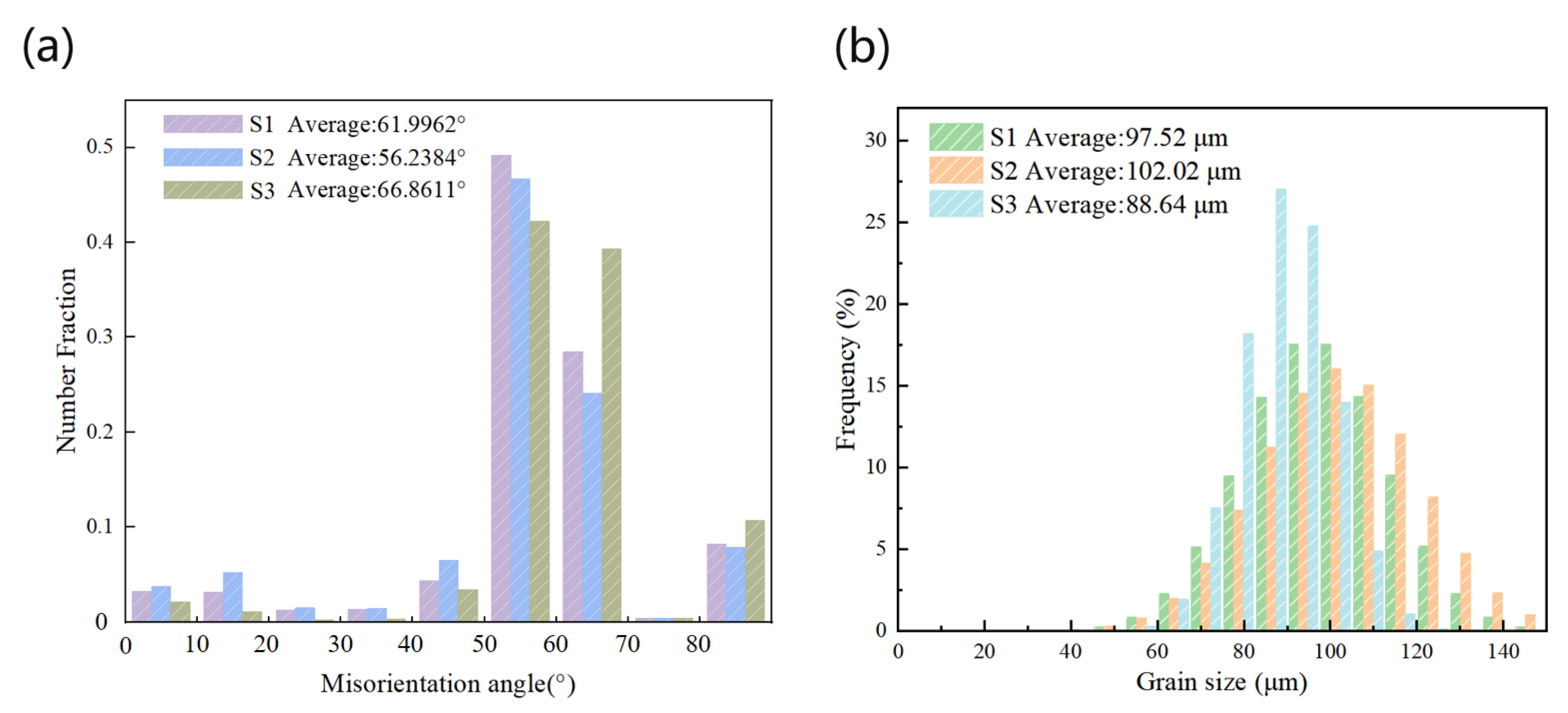
| Element | Al | V | Fe | C | O | N | Ti |
| wt.% | 6.37 | 3.88 | ≤0.20 | ≤0.05 | ≤0.05 | ≤0.05 | Balance |
| Scanning Strategy (Rotation Angle) | UTS (MPa) | YS (%) | Ref. |
|---|---|---|---|
| Alternating (45°) | 1126 ± 16 | 6.05 ± 0.5 | [34] |
| Alternating (90°) | 1079 ± 20 | 6.9 ± 0.7 | [34] |
| Chessboard | 1126 ± 16 | 7.85 ± 1 | [34] |
| Chessboard (45°) | 1150 ±15 | 5.45 ± 0.3 | [34] |
| Chessboard (90°) | 1090 ± 12 | 8.23 ± 1.1 | [34] |
| Stripe | 1094–1158 | 9.3–10.4 | [29] |
| Case | S1 | S2 | S3 |
|---|---|---|---|
| α′ (%) | 41.7% | 33.9% | 53.3% |
| α (%) | 58.3% | 66.1% | 46.7% |
Disclaimer/Publisher’s Note: The statements, opinions and data contained in all publications are solely those of the individual author(s) and contributor(s) and not of MDPI and/or the editor(s). MDPI and/or the editor(s) disclaim responsibility for any injury to people or property resulting from any ideas, methods, instructions or products referred to in the content. |
© 2025 by the authors. Licensee MDPI, Basel, Switzerland. This article is an open access article distributed under the terms and conditions of the Creative Commons Attribution (CC BY) license (https://creativecommons.org/licenses/by/4.0/).
Share and Cite
Zhang, H.; Cai, C.; Yan, L.; Gong, H.; Yang, J. Optimization of Microstructure and Strength–Ductility Synergy in Selective Laser-Melted Ti6Al4V Alloy via Chessboard Scanning Strategy. Metals 2025, 15, 1224. https://doi.org/10.3390/met15111224
Zhang H, Cai C, Yan L, Gong H, Yang J. Optimization of Microstructure and Strength–Ductility Synergy in Selective Laser-Melted Ti6Al4V Alloy via Chessboard Scanning Strategy. Metals. 2025; 15(11):1224. https://doi.org/10.3390/met15111224
Chicago/Turabian StyleZhang, Haochun, Chilan Cai, Liang Yan, Hailin Gong, and Jin Yang. 2025. "Optimization of Microstructure and Strength–Ductility Synergy in Selective Laser-Melted Ti6Al4V Alloy via Chessboard Scanning Strategy" Metals 15, no. 11: 1224. https://doi.org/10.3390/met15111224
APA StyleZhang, H., Cai, C., Yan, L., Gong, H., & Yang, J. (2025). Optimization of Microstructure and Strength–Ductility Synergy in Selective Laser-Melted Ti6Al4V Alloy via Chessboard Scanning Strategy. Metals, 15(11), 1224. https://doi.org/10.3390/met15111224






